Harley-Davidson has come out swinging for 2018 with an expanded Softail range of eight models built on an all-new, lighter and stiffer chassis. The old 103 Twin Cam engine is gone, replaced by a smoother and more powerful oil- and air-cooled, four-valves-per-cylinder 107 Milwaukee Eight engine, with an optional 114 M-8 donk available in four of the models.
The eight new Softail models are the stars of an impressive 2018 Harley-Davidson model
line-up revealed in AMCN Vol67 No05.
We were invited to California for a two-day road trip to put this new Softail range to the test. From our base in Pasadena, we blasted our way through a thousand twists and turns as we snaked up into the mountains around Big Bear and Lake Arrowhead.
While a Hog may not be everyone’s cup of cubic inches, we should take note of what the American marque is up to. Already selling more road bikes in Australia than anyone else, the new Softail range is part of the company’s biggest ever R&D project. Harley appears determined to retain its number one status by offering a style of bike to suit just about every big V-Twin lover’s taste and budget.
The entry point is the Street Bob for $23,495 (ride away), and for that you are getting a better looking, better handling and more stylish Softail than ever before. Traction control and selectable riding modes still do not form part of the H-D vernacular, but the Milwaukee decision makers know this is how Harley buyers like their riding; pure, with attitude and little fuss.
However, the new season isn’t all about expansion. The twin rear shock Dyna range has been deleted from the line-up, and the Low Rider, Fat Bob and Street Bob have become Softail models, built on the all-new monoshock chassis. Also deleted is the first Harley-Davidson to carry a radiator, the V-Rod.
These were huge decisions by the 115-year-old manufacturer, which trades heavily on its rich heritage. But the changes are all part of a long-term strategy it calls future proofing. The company makes no secret of its plans to release 100 new models over the next decade, so it is not planning on slowing down anytime soon.
As we landed in Los Angeles, the ink was still drying on the press releases announcing Harley’s 2018 plans, so there was a plethora of information to absorb. There are changes across the entire range, but it’s the 2018 Softails that headline the show – the Fat Boy, Heritage Classic, Breakout, Fat Bob, Deluxe, Softail Slim, Low Rider and Street Bob.
The first four are available with the optional 114 Milwaukee Eight engine, while the rest are offered only with the 107 M-8 unit. Make sense? Great, let’s go ride some Softails.
Street Bob
The first bike I rode at the Softail range world launch didn’t start life as a Softail; the Street Bob is one of three Dyna models to shed its twin rear shocks and become a Softail for 2018. It’s going to take a bit of time for the Dyna guys to come around, but once they ride the new bike I think they will be sold. The Street Bob has a lot of pressure riding on its single seat as the entry point to Harley’s big V-twin range but after our all-too-brief time together, it has nothing to worry about.
The Street Bob has mid-mounted controls, something I have been wary of since tripping over the controls of the Roadster model, but they work extremely well with this bike’s ergonomics. I didn’t catch my ankles on the ’pegs once.
I may have looked like a giant on it, but didn’t feel cramped and, while I prefer forward controls to stretch out, the ergonomics of the Street Bob suit tall and short riders alike.
I’d been briefed on the new miniature digital instrument panel mounted on the handlebar riser (photo below), but still wasn’t prepared for how small the unit is. Despite its micro size, the information is easy to access and read. The small instrument panel tops off the minimalist, chopped-back look of the Street Bob with its cut fenders, flat-top tank and single seat. It’s also the lightest of the new Softails at a claimed 297kg (wet).
While not a huge fan of ape hangers, the mini jobs look cool and help bring out the bike’s fun nature. The high-set ’bar and skinny front tyre (mounted on a 19-inch wheel) restricts your ability to throw it around as well as some of the other bikes in the range, but it’s a confident little handler thanks to the new Showa Dual Bending Valve (SDBV) fork, mated to the more rigid and lighter monoshock chassis. The improved handling of the 2018 Softail range was evident from my first ride, and stretched through the eight-bike range.
On the comfort front, I felt a little tightness creeping into my shoulders so I don’t think I could ride it all day, and with my big, gangly arms the only thing I could see in the mirrors that hang directly below the hand grips was… my own arms.
Being the first bike I rode, it’s also the one that revealed just how quiet the M-8 engine is. At first, I was a little disappointed at the lack of noise. Once behind other bikes, I realised the exhaust sound was there, though with a subdued note from the stock system. All the same, the engine and induction noise is considerably reduced.
What I liked: It lets you get into the big V-twin Milwaukee Eight range at a sub-$24K ride-away price.
What I didn’t like: Hard to fault a bike that does exactly what it says it will on the tin.
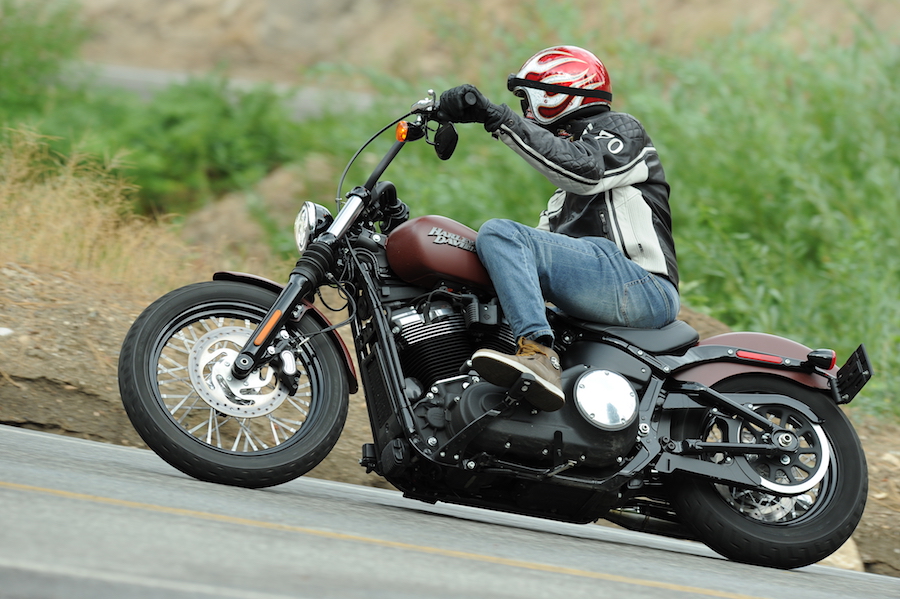
Price $23,495 (ride away)
Engine 107 Milwaukee Eight (145Nm)
Seat Height 690mm
Wet weight 297kg (claimed)
Colours Vivid Black, Olive Gold, Red Iron Denim, Wicked Red, Industrial Grey/Black Denim
Softail Slim
The Softail Slim was the surprise package of the launch for me. I’m a big fan of the bobber style and the Slim pulls off the stripped-back retro look better than any other model. It’s got just the right amount of black finish mixed with touches of chrome, and a chrome exhaust system.
The bike feels much more planted than last year’s model and the 107 M-8 engine is not only smoother and quieter than the 103 unit, thanks to dual-counterbalanced internals, it delivers more power in a much more enjoyable way. It may be the same engine as all the other Softails, but the improvements seem much more noticeable riding the Softail Slim.
The 660mm height of the tuck-and-roll is the lowest in the Softail range, allowing just about anyone to get a foot on the ground, but surprisingly it did not feel as cramped as the Low Rider and Street Bob with their 30mm-higher 690mm seat heights. The reach to the wide Hollywood ’bar was just right for me, so those with shorter arms may need to lean forward a little, but that will allow your flannel shirt to flap in the breeze better – and that’s what it’s all about.
The bike-swap rotation meant I was on the Slim for some of the fastest and twistiest sections, and being slim by name as well as by nature – with a 150 rear tyre and 130 front on 16-inch laced rims – made it easy to flick the bike from side to side. The single front 300mm disc and four-pot caliper failed to put up any protest to the punishment I was handing out, leaving the rear brake free to gently steady the bike mid-corner.
This is one bike I thought would work with the 114 Milwaukee Eight option, though that’s not to say it doesn’t make the most of the rigid-mounted 107 engine, which is quite possibly the best choice for this bike.
Another Softail improvement for 2018 is the extra lean angle courtesy of higher ground clearance and narrower footboards. Gone is the annoying sound of a dragging footboard that signified inadequate ground clearance, replaced by a touchdown every-so-often when you are having a go. Having a go also means plenty of gear changes allowing the light lever on the assist clutch to shine.
What I liked: This was one of my favourite rides of the two-day launch. The stripped-down look and quick handling makes it a joy to ride.
What I didn’t like: Having to move to the next bike
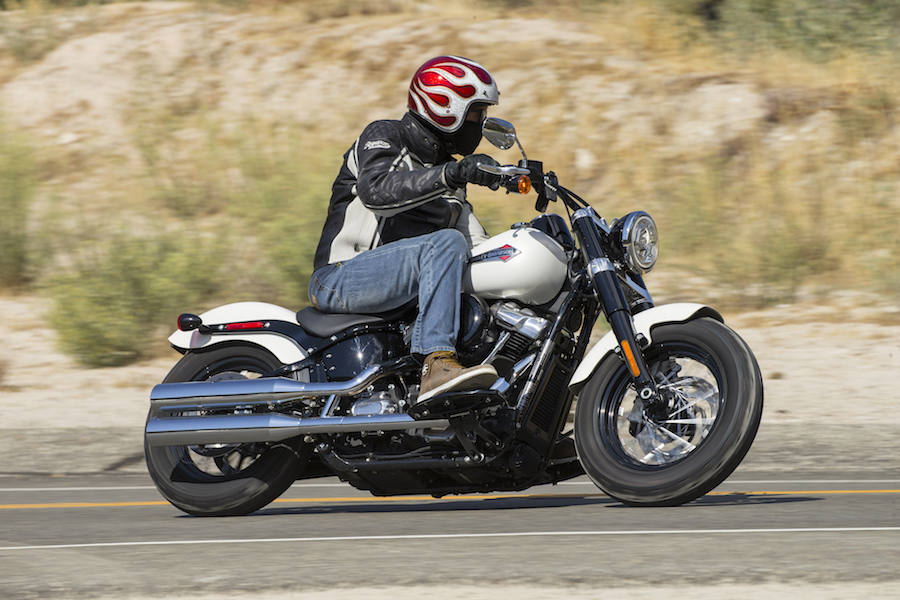
Price $26,250 (ride away)
Engine 107 Milwaukee Eight (145Nm)
Seat Height 660mm
Wet weight 304kg (claimed)
Colours Vivid Black, Wicked Red, Electric Blue, Bonneville Salt Pearl
Deluxe
I wasn’t scheduled to ride the Deluxe until towards the end of the launch, so I could only gaze at it and listen to what those before me thought of the bike while I awaited my turn.
The Deluxe is all classic Harley style – whitewall tyres, miles of chrome, big wraparound wheel guards and a choice of bold colours – and the fact that my new Airoh helmet matched the bike maybe just a bit too perfectly, added to the moment when I finally got to spend some one-on-one time with it.
Once you’re moving, with your feet planted on the footboards, and gripping the wide, pulled-back ’bar, it doesn’t matter if you are going fast or slow, dragging a footboard or cruising the beach-front, you just feel relaxed, cool and comfortable.
Being a single-seat bike like the Softail Slim and Street Bob, you get a little more room to move.
Despite having lashings of chrome, It’s 17kg lighter than the previous model, and the 30-degree steering angle and new chassis allows a serious crack at the twisties. No longer do you need to sacrifice handling and braking for old-school looks and style.
The Deluxe is closely related to the Heritage, but calling the Heritage ‘a Deluxe with a screen and bags’ would sell them both short. However, I would probably be happy with a Deluxe and a set of removable bags and removable screen in the garage for those longer trips, and the single seat lets me tour alone,
There are a couple of bikes in the new Softail range that I wish had the 114 engine option, and the Deluxe is one of them. A motorcycle with the prestige and presence of the Deluxe needs a premium model choice.
What I liked: A genuine showstopper, not a pretender
What I didn’t like: Doesn’t come with the 114 engine option, but shut up and take my money anyway
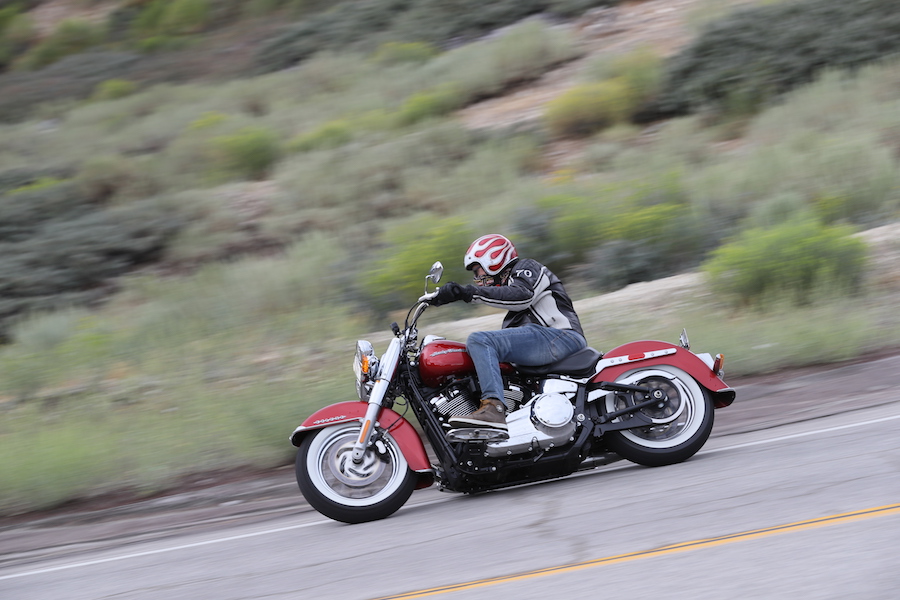
Price $29,495 (ride away)
Engine 107 standard (145Nm)
Seat Height 680mm
Wet weight 303kg (claimed)
Colours Vivid Black, Twisted Cherry, Electric Blue, Silver Fortune/Samatra Brown, Wicked Red/Twisted Cherry
Fat Bob
Harley has remained true to its roots with the styling of the new Softail range, with one exception – the new Fat Bob. It’s so radically different from the previous model, and even the other Softail models, that you need to take a moment to soak it all in before you ride it.
A 43mm inverted front fork might be the norm for other manufacturers, but it’s big news on a Harley cruiser.
Sitting between the fork legs is a menacing-looking rectangular LED headlight. The wheels are 16-inch cast units with fat deep-tread tyres. The rear fender makes it look like a flat tracker, but the way the header pipes snake around the big V-twin before sweeping upwards is very European.
Interestingly, Harley decided not to go with the small riser-mounted digital dash for the Fat Bob, instead adding a single round gauge to the top of the tank – some things need to remain old-school.
Performance is what the Fat Bob is all about, and a 28-degree steering rake with 132mm of trail gives it a sporty turn that’s assisted by the stiffer Softail chassis. Ground clearance of 120mm provides additional lean angle, allowing the rider to put the quick steering to good use.
The Fat Bob also has a remote rear shock adjuster so you can easily play with the suspension preload, but the fork legs are non-adjustable.
This is a feet-forward cruiser with pegs, not boards. Mid-mount controls may be sportier, but feet-forward is what a cruiser is about, and the Fat Bob is that. The 710mm-high flat seat feels much higher than the other models; it’s like getting onto a Motard bike. The ’bar is also fat, flat and wide yet you don’t need to stretch to reach it due to the relatively short seat-to-bar measurement.
Besides its Mad Max looks, the big surprise with the Fat Bob is its handling. With fat tyres front and rear, and a 1630mm wheelbase, you’d expect it to be stable – and it is, but it also corners well thanks to the leverage you can transfer to the steering via the wide ’bar. The firm suspension and stiffness of the frame provide excellent feedback and, despite having an aggressive tread pattern on the balloon-type tyres, it turns well, providing plenty of grip and feel.
Stopping is handled by twin 300mm discs up front, the only Softail with this set-up. They provide a good solid feel from the moment you apply pressure to the lever to the moment you come to a stop.
“I need your clothes, your boots, and your moto-cycle.” Those immortal words by Arnold Schwarzenegger in Terminator II helped rocket the popularity of Harley-Davidson’s Fat Boy model into the stratosphere. Ask 100 random Aussies to name five Harley-Davidson models and it’s a safe bet that most will list the Fat Boy; for many it will be the only H-D model they know. It’s estimated there are more than half a million Fat Boys in service at the moment.
Cue George Thorogood’s Bad to the Bone as the backing track to this review…
What I liked: A real Surprise package from Harley-Davidson that shows they are not afraid to try something different.
What I didn’t like:
I didn’t get to ride one fitted with the 114 engine, which I reckon would be a hoot.
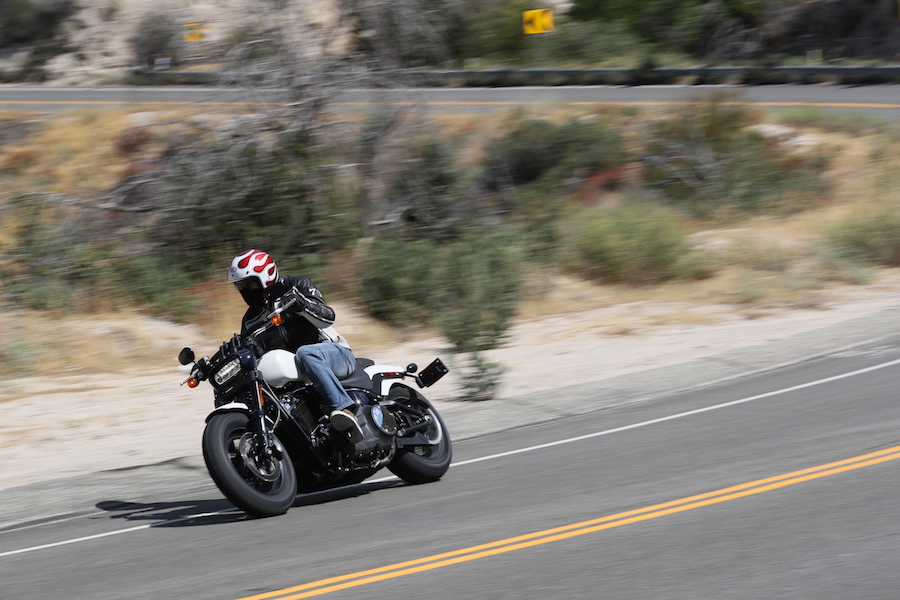
Price $27,495 (ride away)
Engine 107 standard (145Nm) /
114 option ($30,250 ride away)
Seat Height 710 mm
Wet weight 306kg (claimed)
Colours Vivid Black, Black Denim, Red Iron Denim, Bonneville Salt Pearl, Industrial Grey
Fat Boy
The Fat Boy has always been known for its tough looks and, despite a major makeover for 2018, it has lost none of its bad-boy image. Sitting on fat 240 rear and 160 front tyres, mounted on solid Lakester 18-inch wheels, there’s no mistaking the Fat Boy for any other model.
The new Fat Boy receives the wider-swingarm Softail chassis to accommodate the super-fat rubber. The 675mm-high seat slopes up to the petrol tank as well as up the rear guard, so you slide into it and stay there.
The big, wide, fat ’bar is an easy reach and it’s pure
Harley-Davidson attitude once you have your feet on the forward-control footboards and you’re rolling.
The wheels and satin chrome that adorns the new Fat Boy drives home the fact this model is all about making a statement and being seen; it’s a cruiser in the real sense of the word.
Those fat front and rear tyres combined with a 1665mm wheelbase make for hard work on a twisting road but, as we also discovered with the Breakout, the new Softail goes a long way to making the Fat Boy’s docile handling more a characteristic than a chore.
With the standard 107 M-8 engine fitted, the new Fat Boy is claimed to be 16kg lighter than the 2017 model, which is a good thing because the new Softail chassis features a smaller side-stand that is a little harder to manipulate under the Fat Boy’s footboards. I had a close call when I thought the side stand was in the engaged position and was lucky to keep the test bike upright.
What I liked: You just can’t beat the feeling you get when riding a Fat Boy. Everyone from little old ladies to policemen look and wave when they see one.
What I didn’t like: Not much, it hits its design brief perfectly.

Price $30,995 (ride away); also available in a choice of two 115th Anniversary limited-edition models with the 114 engine ($34,750)
Engine 107 standard (145Nm)
114 Option ($33,995 ride away)
Seat height 675mm
Wet weight 317kg (claimed)
Colours Vivid Black, Black Tempest, Industrial Gray, Bonneville Salt Pearl, Wicked Red/Twisted Cherry, Silver Fortune/Samatra Brown, Legend Blue/Vivid Black, Legend Blue Denim
Breakout
It has been Harley’s top-selling road bike for years, and now it’s even better. The option for buyers to step up from the 107 cubic-inch Milwaukee Eight to the 114ci unit provides additional punch to match the bike’s drag racing style.
It gets a new LED headlight that looks great from the front, but seems a bit unfinished from the rider’s seat. It also gets the mini digital instrument panel integrated into the handlebar riser, and a reprofiled but smaller-capacity fuel tank that makes it appear sleeker than the 2017 model. The tank now has a 13.2-litre capacity, down from 18.9, but reduced weight and improved fuel economy should help balance the ledger.
The Breakout is one of three 2018 Softail models fitted with a remote preload adjustment knob, which is handy for big guys like me riding a bike that has so much going on at the rear with the wider swingarm and fat 240 tyre. Add to that the raked-out forks, with 34° of head angle and 145mm of trail, and you have a bike that needs to beat basic engineering sense into submission to work – and amazingly it does.
The 34 per cent-stiffer frame, new mono shock and twin-valve 49mm forks combine for much-improved handling. It’s still wouldn’t win a round of the ASBK, but once you get your head around the bike’s slight reluctance to lean into a bend, or quickly change direction, it becomes a hoot to ride.
Of the eight Softail models I tested, the Breakout is in my top three on the enjoyment scale, and I rode it the hardest. Sure, the pegs grind the bitumen through corners, but nowhere near as much as the previous model, which I found quickly became a chore to ride.
The improvement comes from a better chassis with much less flex, and increased lean angle courtesy of an upward tilt of the transmission. I found hanging off it like a sidecar rider worked much more effectively than just grinding the pegs down.
Even with the increased rotating mass of the rear wheel, the brakes never gave any concern, although the rear was pretty shagged by the time I threw a leg over it.
Another improvement over the old Breakout is the comfort. The new bike fitted me better, and probably went a long way to instilling confidence quickly.
What I liked: A fun ride that looks great and offers a lot more feedback than the spec sheet may suggest.
What I didn’t like: Feel at the rear quickly disappeared when we encountered wet roads.
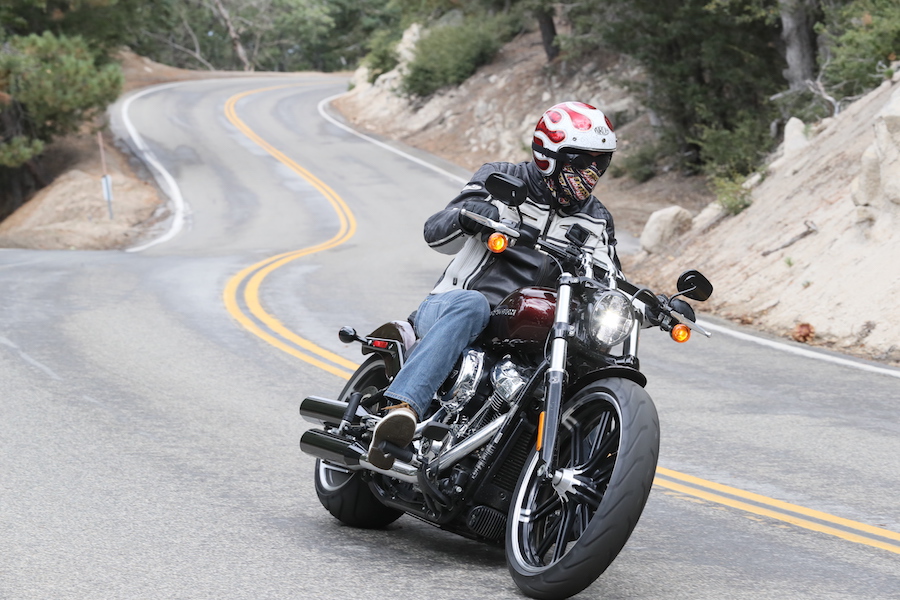
Price $31,250 (ride away); also available in 115th Anniversary limited edition with 114 engine ($34,495)
Engine 107 standard (145Nm)
114 Option ($33,995 ride away)
Seat height 665mm
Wet weight 305kg (claimed)
Colours Vivid Black, Black Tempest, Twisted Cherry, Silver Fortune, Legend Blue Denim
Heritage Classic
The Heritage Classic is the most expensive model in the Softail range. It’s also the only model to have cruise control as standard. It is also fitted with uprated rear suspension to deal with the extra payload of full panniers and a passenger, and if you need extra grunt to lug that extra payload you can order it with the 114 Milwaukee Eight engine, which is the model I tested on the launch program.
Imagine dropping a 72kg anvil on your foot. That’s the weight difference between Harley-Davidson’s popular Street Glide Special tourer at 388kg (wet) and the Heritage Classic at 316kg. That’s the secret to the Heritage Classic; it’s a lightweight Harley tourer that’s as easy as kindergarten math to ride.
It also has a classic 1950s style with a blacked-out engine, 16-inch spoked wheels and chrome twin exhausts. The screen is detachable, and the bike looks great with or without it. I did experience some buffeting at highway speeds about 120km/h.
With a big fat comfy seat, an easy reach to the swept-back ’bar and big footboards, this is an easy all-day rider.
I found myself on this bike in stifling mid-40-degree Californian heat and was glad to have a ride that takes so little effort to punt around. I was also very popular with the other riders due to the lockable bags carrying bottles of water.
The pillion seat may not be overly large, but it’s flat and well positioned, something the Street Glide’s pillion perch is not, so I’m looking forward to getting Mrs D on the back of one for a bit of two-up touring when the new models arrive Down Under.
What I liked: It’s a Harley-Davidson tourer without the weight, and with great handling manners.
What I didn’t like: You need to remove the seat and use a supplied tool to adjust the preload on the rear shock (left), even though other Softail models have an easy-to-use remote adjuster. To me, that decision is a real head-scratcher. Harley’s designers claim the decision not to fit a remote preload adjuster was for looks, but I’m not convinced.

Price $31,750 (ride away); also available in 115th Anniversary limited edition with 114 engine $34,750
Engine 107 standard (145Nm)
114 option ($33,995 ride away) Seat Height 680mm
Wet weight 330kg (claimed)
Colours Vivid Black, Twisted Cherry, Silver Fortune,
Olive Gold/Black Tempest, Industrial Gray Denim/Black Denim, Red Iron Denim, Legend Blue/Vivid Black
Low Rider
The big news for one of H-D’s most loved models is it’s no longer a Dyna but a Softail. And if you think the loss of dual rear shocks is no big deal for dyed-in-the-wool Harley lovers, just check out a few online forums – this is a big call by the company.
The Low Rider has all the style of a 70s chopper, including two tank-mounted dials, a cut-down front fender and a low rear fender with a big stop-light.
There’s lots of chrome, a round headlight with a chrome visor, and a seat that starts low and rises over the rear guard so your significant other has a great view of the world. It’s the second-least-expensive bike in the new Softail range, and there isn’t much to dislike – unless you’re tall and lanky like me.
The low 690mm seat height and high mid-mount controls coupled with a drastically swept-back handlebar would be brilliant for someone six feet tall or less, but for guys like me it’s a bit weird. And unlike the Street Bob, which has the same seat height, I found myself tripping over the mid-mount controls when I came to a stop.
It’s not all bad news, though; I love that the bike feels like the dragster pushbike I got for Christmas in 1975. Everything about this bike screams ‘retro’ except for the ride from the new monoshock chassis, and the 107’s smooth power delivery.
Despite feeling cramped, and very self-conscious about how I looked, I enjoyed the ride, but enjoyed standing back and just admiring the bike even more.
The big chrome binnacle on the tank houses two four-inch analogue dials, one for speed and one for revs. The digital insert for gear position, trip and fuel is one of the few things that doesn’t look 1970s. The air-filter cover, tank graphics, 19-inch front wheel (which dwarfs the 16-inch rear), lashings of chrome and a chopper-style front end with 30-degree rake and 163mm trail are all Starsky and Hutch era-inspired.
I like what H-D has done with the styling despite the loss of the twin rear shocks. Only time will tell if the Harley faithful feel the same way.
What I liked: The groovy 1970s look; the Low Rider was the first of Harley’s factory customs in 1977, so it’s the real deal.
What I didn’t like: It’s not for tall people.
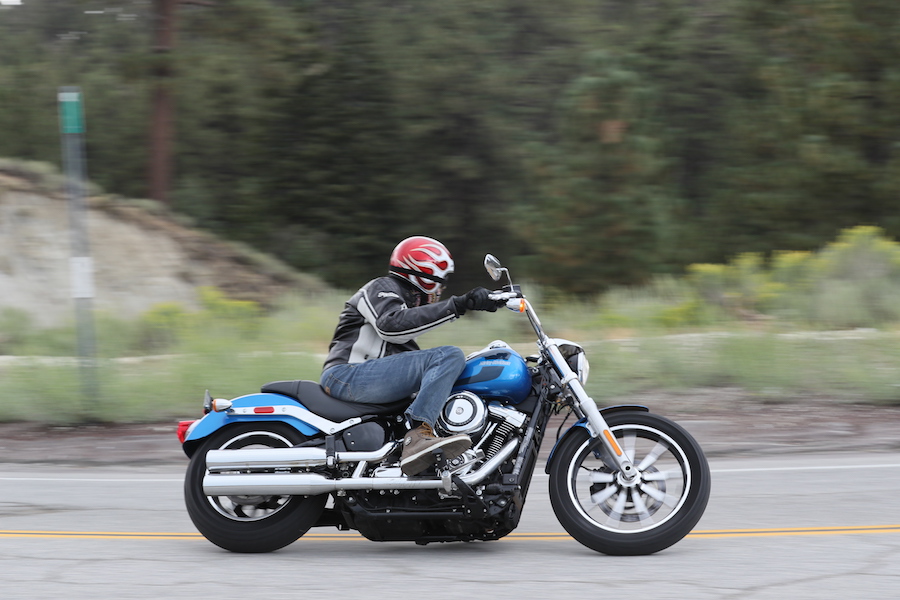
Price $24,250 (ride away)
Engine 107 Milwaukee Eight (145Nm)
Seat height 690mm
Wet weight 287kg (claimed)
Colours Vivid Black, Wicked Red, Electric Blue, Bonneville Salt Pearl











